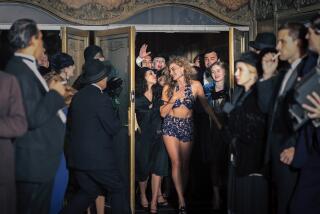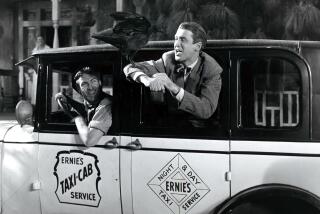MOVIE REVIEWS : Celebrating Chaplin Centenary
- Share via
Hollywood Heritage and the Silent Society join forces Sunday at 6 p.m. to celebrate the 100th anniversary of the birth of Charles Chaplin with a screening of the rarely seen, 12-minute “How to Make a Movie” (1918) and a final public showing of “The Kid” (1921), which along with the other Chaplin classics will be out of theatrical release for the next seven years.
Along with ceremonies in which Chaplin’s son Sydney will participate, the films will be presented at the Chaplin Stage at A&M; Records on La Brea and De Longpre avenues, site of the original Chaplin Studios.
“How to Make a Movie” is part of the treasure trove that Lady Chaplin made available to film historians Kevin Brownlow and David Gill for their fascinating Thames Television series “The Unknown Chaplin.” Outtakes and other odd bits and pieces of film that Chaplin had preserved allowed us to witness how this perfectionist film maker-clown went about creating his comedy.
“How to Make a Movie,” however, is Chaplin’s brief, off-the-cuff celebration of the opening of his new studio and as such is probably the most purely joyous piece of film he ever shot. He shows us, via time-lapse photography, a citrus grove being replaced with a movie studio whose office design he self-mockingly calls “Ye Olde English Village”--and which are remarkably intact today. We see the beamingly happy and dapper 29-year-old Chaplin give a pretty girl a screen test; put on his “greatest treasures,” his famous Tramp shoes, kept in a vault, and apply his “Million Dollar Moustache.” There are a few bits of information about how film is processed in the laboratory, but “How to Make a Movie” is all in fun.
“The Kid,” which has the airy grace and exuberance of a ballet, introduced the late Jackie Coogan, who overnight became the most famous child star of the time, and nearly 70 years later both the film and Coogan prove irresistible. Coogan plays a 5-year-old, abandoned shortly after birth and rescued by Chaplin’s inimitable Tramp. The two, happy together, survive by their wits but, naturally, this idyllic relationship will soon be threatened.
Chaplin keeps “The Kid” from becoming too saccharine with his formidable sense of humor coupled with the duo’s equally impressive resilience. The film lives up to its introductory description: “A picture with a smile--and, perhaps, a tear.” “The Kid” endures, as do all the Chaplin films, because of Chaplin’s unique eloquence and impeccable timing. Note: a teen-aged Lita Grey, who became Chaplin’s second wife and the mother of his two eldest sons, can be glimpsed briefly as a notably flirtatious angel in a dream sequence.
Information: (213) 874-4005, (213) 937-0776 or (818) 248-2569.
More to Read
Only good movies
Get the Indie Focus newsletter, Mark Olsen's weekly guide to the world of cinema.
You may occasionally receive promotional content from the Los Angeles Times.










